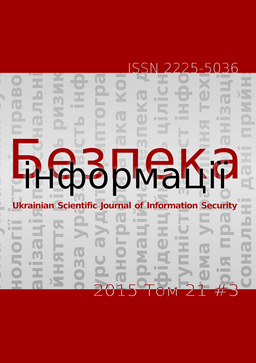Modern approaches to critical infrastructure objects detection and identification
DOI:
https://doi.org/10.18372/2225-5036.21.9690Keywords:
information security of the state, critical infrastructure, identification, criticality level evaluation, critical information infrastructure, critical information infrastructure protectionAbstract
Modern trends in information technologies led phenomenal dependence on public services, which provide by different spheres of infrastructure. Today, quality and accessibility of services is one of the main indicators of the state infrastructure level, and ensure their security and stable operation is an essential and indispensable part of the national security of developed countries. Increased concentrations of tools and resources to secure various types of electronic infrastructure necessitated ranking of infrastructure facilities, the allocation of the most important ones and the emergence of the concept of critical infrastructure. In view of this, in the paper the multi criteria analysis of approaches was carried out to identify critical facilities to assess their capacity to detect and identify the most important objects of critical information infrastructure. It was established that the most effective information infrastructure approaches are based on graph theory and simulation, but most existing approaches do not take into account the full set of parameters and information component. That’s why the development of a universal method for critical information infrastructure identification is necessary.References
Бірюков Д.С. Захист критичної інфра-структури: проблеми та перспективи впровадження в Україні / Д.С. Бірюков, С.І. Кондратов. — К. : НІСД, 2012. — 96 с.
Keating С, Rogers R., Unal R., Dryer D., Safford R., Peterson W., Rabadi G. System of Systems Engineerings // Engineering Management Journal, Vol. 15, № 3, 2003. — p. 36-45.
Jackson M.C. Systems Methodology for the Management Sciences // New York: Plenum, 1991. — 81 p.
Лядовська В.М. Визначення критичної інформаційної інфраструктури та її захист: аналіз підходів / В.М. Лядовська, М.О. Рябий, С.О. Гнатюк // Зв'язок. — 2014. — №4. — С. 3-7.
Clausewitz C.-V.. On War // Swedish translation by Mertensson, Buhme och Johansson. Stockholm, Sweden: Bonnier Fakta Bokfurlag. 1991. — p. 1832.
Кондратьев А. Современные тенденции в исследовании критической инфраструктуры в зарубежных странах // Зарубежное военное обозрение. — 2012. — №1. − С. 19-30.
Курносов Ю.В., Конотопов П.Ю. Аналитика. Методология, технология и организация информа-ционно-аналитической работы. —М., 2004. — 135 с.
Пугачева Е.Г. Идеи теории сложных систем и их применение в экономике // Проблеми системного підходу в економіці: Збірник наукових праць: Вип. 31. — К.: НАУ, 2009. — С. 36-45.
КВИС — критически важные информаци-онные сегменты [Электр. ресурс]. — Режим доступа: http://security-corp.org/administration/network_tech nologies/4580-kvis-kriticheski-vazhnye-informacionnye -segmenty.html.
Стиславский А.Б. Построение методолог-гии обеспечения транспортной безопасности на основе категорирования // Вісник Національного університету водного господарства та природо-користувания. — Рівне: НУВГП, Зб. наук.пр. — Ч.2. — № 3 (47), 2009. — С. 155-165.
Братушка С.М. Імітаційне моделювання як інструмент дослідження складних економічних систем / С. М. Братушка // Наук. вісн. НЛТУ України. — 2009. — № 8. — С. 22-28.
Dudenhoeffer D., Permann M., Manic M. CIMS: a framework for infrastructure interdependency modeling and analysis // Proceedings of the Winter Simulation Conference WSC 2006, Monterey,California, USA. — p. 478-485.
Гнатюк С.О. Кібертероризм: історія розвитку, сучасні тенденції та контрзаходи / С.О. Гнатюк // Безпека інформації. — Том 19, №2. — 2013. — С. 118-129.

